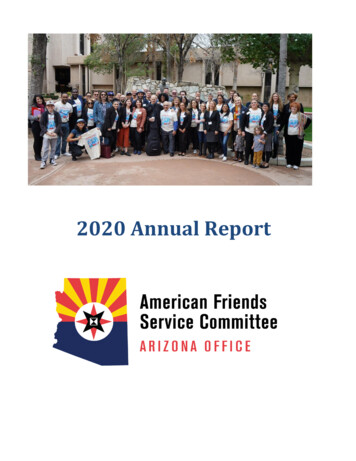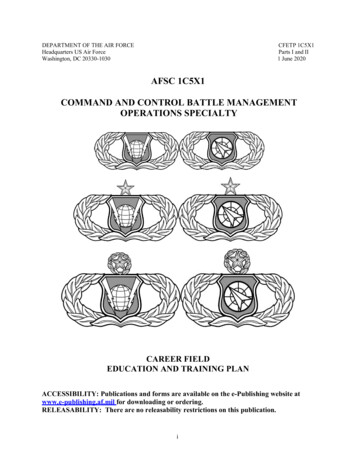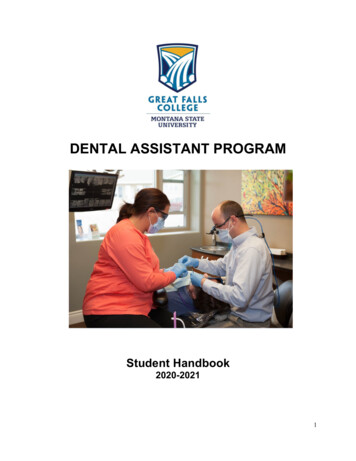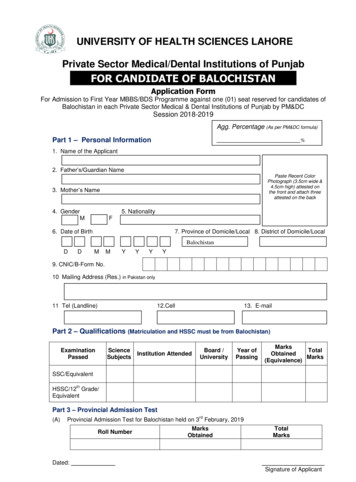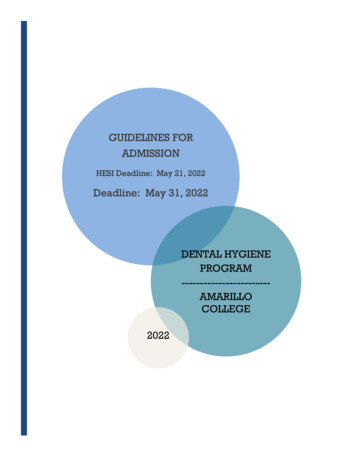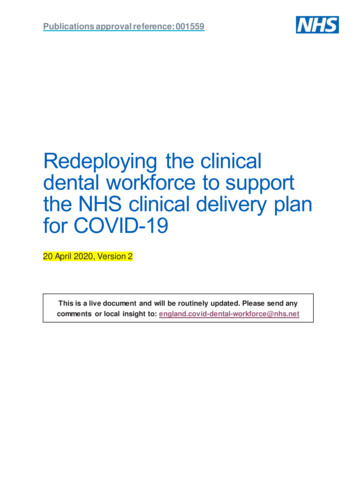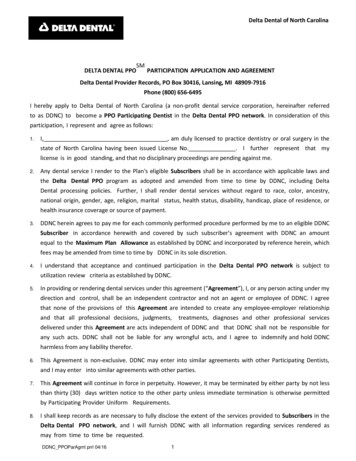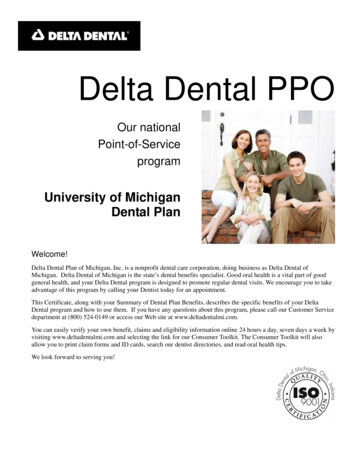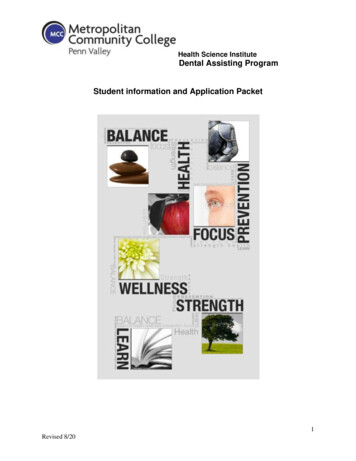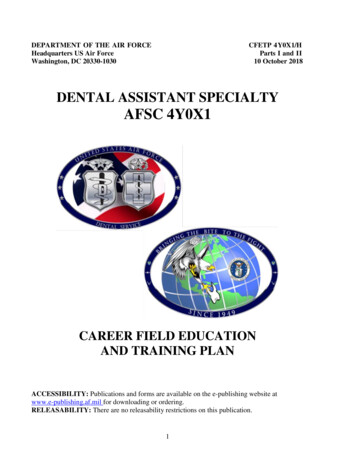
Transcription
DEPARTMENT OF THE AIR FORCEHeadquarters US Air ForceWashington, DC 20330-1030CFETP 4Y0X1/HParts I and II10 October 2018DENTAL ASSISTANT SPECIALTYAFSC 4Y0X1CAREER FIELD EDUCATIONAND TRAINING PLANACCESSIBILITY: Publications and forms are available on the e-publishing website atwww.e-publishing.af.mil for downloading or ordering.RELEASABILITY: There are no releasability restrictions on this publication.1
CAREER FIELD EDUCATION AND TRAINING PLANDENTAL ASSISTANT SPECIALTYAFSC 4Y0X1Table of ContentsPART IPreface . . 3Abbreviations/Terms Explained . 4Section A - General Information 7PurposeUsesCoordination and ApprovalSection B - Career Progression and Information . 8Specialty DescriptionSkill/Career ProgressionApprentice(3) LevelJourneyman(5) LevelCraftsman(7) LevelSuperintendent (9) LevelTraining DecisionsCCAF Career Field PathSection C - Skill Level Training Requirements . 15PurposeSpecialty Qualification RequirementsSection D - Resource Constraints . . 16Section E - Transitional Training Guide . 16PART IISection A - Specialty Training Standard . 17Section B - Course Objective List . . . . . 35Section C - Support Material . . . 35Section D - Training Course Index . . 35Section E - MAJCOM Unique Requirements . . . 36Section F - Documenting Training . 37Supersedes: CFETP 4Y0X1, 1 Aug 2012OPR: AF/SG1EApproved by: CMSgt Randy C. Lightsey (AFMOA/SGD)2
CAREER FIELD EDUCATION AND TRAINING PLANDENTAL ASSISTANT SPECIALTYAFSC 4Y0X1/HPart 1PrefaceThis Career Field Education and Training Plan (CFETP) is a comprehensive education and trainingdocument identifying the life-cycle education and training requirements, training supportresources, and minimum core task requirements for this specialty. The CFETP provides a clearcareer path to success and instill rigor in all aspects of our career field training. NOTE: Civiliansoccupying associated positions will use Part II to support duty position qualification training.The CFETP consists of two parts. Supervisors plan, manage, and control training within thespecialty using both parts of the plan.Part I provides information necessary for overall management of the specialty. Section Aexplains how everyone will use the CFETP; Section B identifies career field progressioninformation, duties and responsibilities, training strategies, and the career field path; Section Cassociates each skill-level with specialty qualifications (knowledge, education, experience, training,and other); and Section D indicates resource constraints. Some examples are funds, manpower,equipment, facilities; Section E identifies transition training guide requirements for SSgt throughMSgt.Part II includes the following: Section A: identifies the Specialty Training Standard (STS) andincludes duties, tasks technical references to support training, Air Education and TrainingCommand (AETC) conducted training, core and critical tasks, and correspondence courserequirements. Section B: contains the course objective list and training standards supervisors willuse to determine if an Airmen satisfied training requirements. Section C: identifies availablesupport materials (i.e. Qualification Training Packages). Section D: identifies the training courseindex supervisors can use to determine resources available to support training. Included here areboth mandatory and optional courses. Section E: identifies MAJCOM unique trainingrequirements supervisors can use to determine additional training required for the associatedqualification needs. At unit level, supervisors and trainers will use Part II to identify, plan, andconduct training commensurate with the overall goals of this plan.Using guidance provided in the CFETP will ensure individuals in this specialty receive effectiveand efficient training at the appropriate points in their careers. This plan will enable us to traintoday’s work force for tomorrow’s jobs.3
Abbreviations and Terms ExplainedAdvanced Training (AT). Formal courses providing individuals, qualified in one or morepositions of their AFS, with additional skills and knowledge to enhance their expertise in the careerfield. Training is for selected career airmen at the advanced level of AFS.Air Education and Training Command (AETC). Conducts basic training for all Air Force (AF)enlisted personnel, produces skilled flying and ground personnel, and trains many of the world’smilitary forces. Along with basic military, technical, and flying training, AETC provides othertypes of training, such as aircrew transitional, special, advanced, lateral, and survival training.AF Career Field Manager (AFCFM). Representative appointed by the respective HQ USAFDeputy Chief of Staff or Under Secretariat, to ensure assigned AF specialties are trained andutilized to support AF mission requirements. AFCFM is the OPR; however, works in concertwith MAJCOM Functional Managers (MFMs) as required.AF Enlisted Classification Directory (AFECD). The Official directory for all military enlistedclassification descriptions, codes, and identifiers. This directory uses specialty descriptions andcodes to identify each AF job (valid requirements) and describes the minimum mandatoryqualifications of personnel to fill these jobs. The updated AFECD is available at AF PersonnelCenter’s web site located at https://mypers.af.mil/ under the classification menu.Air University (AU/A4L). Provides instructional opportunities for customers beyond the confinesof the formal classroom. AU/A4L has an enrollment, distribution, tracking, and testing system inplace for distance learning courses.AF Job Qualification Standard/Command Job Qualification Standard (AFJQS/CJQS). Thisis a comprehensive task list describing a particular job type or duty position used by supervisorsto document task qualifications. The tasks on the AFJQS/CJQS are common to all persons servingin the described duty position.AF Medical Operations Agency (AFMOA). A Field Operating Agency responsible forproviding operational support to Medical/Dental Treatment Facilities and reach-back support toMAJCOM/SGs.AF Specialty (AFS). A group of positions (with the same title and code) requiring commonqualifications.Career Development Course (CDC). A self-study correspondence course providing Airmen witha fundamental knowledge of their AFS.Certification. A formal indication of an individual’s ability to perform a task to requiredstandards.Certification Official. A person whom the commander assigns to determine an individual’s abilityto perform a task to required standards.4
Chief, Dental Services (CDS). The dental officer in charge of base dental services.Continuation Training. Additional advanced training exceeding the minimum upgrade trainingrequirements with emphasis on present future duty assignments.Core Tasks. Tasks the AFCFM identifies as minimum qualification requirements for everyonewithin an AF specialty code (AFSC), regardless of duty position. Core tasks may be specified fora particular skill level or in general across the AFSC. Guidance for using core tasks can be foundin the applicable CFETP narrative.Course Training Standard (CTS). Identifies a specific course’s training and proficiency level.The CTS is used to identify optional supplemental training requirements, and may also be used toidentify officer CFETP mandatory and optional course requirements.Comprehensive Medical Readiness Program (CMRP). The CMRP is a modernized ReadinessSkills Verification Program (RSVP) that divides medical readiness training into categories tosupport targeted application of requirements for specific specialties, personnel, and missionsacross the full spectrum of AF military medical operations. Category I, Clinical Currency, andCategory II, Readiness Skills Training, are levied using CMRP checklists developed by specialtyconsultants, corps directors and CFMs. Category III, UTC Training, is levied by the Category IIITraining Guide maintained on the AF Medical Readiness SharePoint Site. Category IV, MCRPTeam Training, consists of standardized training required for all like teams across the AFMS aswell as unit-specific training requirements.Critical Task. A task requiring specific training and certification prioritized above other tasks.Tasks may be defined as critical either through AF Instructions (AFIs), Technical Orders, higherheadquarters, or at any level in the unit.Exportable Training. Additional training via computer assisted, read-ahead material (paper text),interactive video, or other necessary means to supplement training.General Education Mobile (GEM). A partnership between Community College of the AF(CCAF) and civilian academic institutions. Under GEM, academic institutions offer generaleducation courses in mobile (distance) learning format in order to meet CCAF Associate ofApplied Science degree requirements.Initial Skills Training. A formal training course awarding an AFSC 3-skill level award to enlistedpersonnel.Major Command (MAJCOM) Functional Manager (MFM). A person appointed as the seniorrepresentative for an AFS within a specific MAJCOM. Among other responsibilities, MAJCOMMFMs work with the AFCFM to develop, implement, and maintain the CFETP. Dental MFMduties are currently being performed by the staff at the AFMOA, Dental Directorate.Mirror Force. Maximizing the mission readiness capability of the AF Medical Service througha combined effort of Active Duty, Reserve, and National Guard by: sharing values and principles;optimizing a total force strategy; using technology effectively and efficiently; training for jointtasking and creating a dynamic environment which maximizes everyone’s potential.5
On-the-Job Training (OJT). Hands-on, “over-the-shoulder” training conducted to certifypersonnel in both upgrade (skill level award and job qualification) and position certificationtraining.Qualification Training Package (QTP). An instructional package designed for use at the unit toqualify, or aid qualification in a duty position or program, on a piece of equipment, or on aperformance item identified for competency verification within this CFETP. QTP’s are designedto establish performance standards, standardize skills verification, and validate taskscompetencies.Resource Constraints. Resource deficiencies, such as money, facilities, time, manpower, andequipment that preclude desired training from being delivered.Skills Training. Training which results in the award of a skill level.Specialty Training. The total training process used to qualify airmen in their assigned specialty.Specialty Training Requirements Team (STRT). A forum led by the AFCFM incorporating theexpertise of the MFMs, subject matter experts (SMEs), and AETC training personnel in order todetermine career ladder training requirements.Specialty Training Standard (STS). An AF publication (typically inserted as Part II of theCFETP) describing an AFS in terms of tasks and identifies knowledge an airman in the specialtymay be expected to perform or to know on the job. Also identifies the training provided to achievea 3, 5, 7, or 9-skill level within an enlisted AFS. It further serves as a contract between AETC andthe functional user to show which of the overall training requirements for an AFSC taught in formalschools and correspondence courses.The Joint Commission (TJC). The Joint Commission evaluates and accredits nearly 16,000health care organizations and programs in the United States. An independent, not-for-profitorganization, it has developed state-of-the-art, professionally based standards and evaluated thecompliance of health care organizations against these benchmarks. Their mission is tocontinuously improve the safety and quality of care provided to the public through the provisionof health care accreditation and related services that support performance improvement in healthcare organizations.Total Force. All collective AF components (active, reserve, guard, and civilian elements) of theUnited States Air Force.Upgrade Training (UGT). Mandatory training which leads to attainment of a higher level ofproficiency.Utilization and Training Workshop (U&TW). A forum led by the AFCFM incorporates theexpertise of the MFMs, SMEs, and AETC training personnel in order to determine career laddertraining requirements. Typically held after the STRT.6
Section A - General Information1. Purpose, Use and Coordination/Approval1.1. Purpose. This CFETP provides information necessary for AF Career Field Managers(AFCFMs), MAJCOM Functional Managers (MFM), commanders, training managers,supervisors, and trainers to plan, develop, manage, and conduct an effective career field-trainingprogram. This plan outlines the training individuals in the 4Y0X1/H specialty must receive inorder to develop and progress throughout their career. This plan identifies initial skills, upgrade,qualification, advanced, and proficiency training. Initial skills training is the AFSC-specifictraining an individual receives upon entry into the AF or upon retraining into this specialty foraward of the 3-skill level. For our career field, the Medical Education and Training Campus(METC) with the support of the 59th Training Group at Fort Sam Houston, TX provides thistraining.1.1.1. Upgrade training identifies the mandatory courses, task qualification requirements, andcorrespondence course completion requirements for award of the 3-, 5-, 7-, and 9-skill levels.Qualification training is actual hands-on task performance training designed to qualify an Airmanin a specific duty position. This training program occurs both during and after the upgrade trainingprocess. Qualification training provides the performance skills and knowledge required to do thejob. Advanced training is formal specialty training used for selected Airmen. Proficiency trainingis additional training provided to personnel to increase their skills and knowledge beyond theminimum required for upgrade. The CFETP has several purposes, some are:1.1.2. Serves as a management tool to plan, manage, conduct, and evaluate a career field trainingprogram. It is also used to help supervisors identify training at the appropriate point in anindividual’s career.1.1.3. Identifies task and knowledge requirements for each skill level in the specialty andrecommends education and training throughout each phase of an individual’s career.1.1.4. Lists training courses available in the specialty, identifies sources of training, and thetraining delivery method.1.1.5. Identifies major resource constraints impacting full implementation of the desired careerfield training process.1.2. Uses. MFMs and supervisors at all levels will use the plan to ensure comprehensive andcohesive training programs are available for each individual in the specialty.1.2.1. AETC training personnel will develop or revise formal resident, non-resident, field, andexportable training based upon requirements established by the users and documented in Part II ofthe CFETP. They will also work with the AFCFM to develop acquisition strategies for obtainingresources needed to provide the identified training.1.2.2. MFMs will ensure their training programs complement the CFETP mandatory initial,upgrade, and proficiency requirements. OJT, resident training, contract training, or exportablecourses can satisfy identified requirements. MAJCOM-developed training to support this AFSCmust be identified for inclusion in this CFETP.7
1.2.3. Each individual will complete the mandatory training requirements specified in this CFETP.Use the list of courses in Part II as a reference to support training.1.3. Coordination and Approval. The AFCFM is the approval authority. MAJCOMrepresentatives and AETC training personnel will identify and coordinate on the career fieldtraining requirements. The AETC training manager for this specialty will initiate an annual reviewof this document by AETC and MFMs to ensure currency and accuracy. Using the list of coursesin Part II, AETC and MFMs will eliminate duplicate training.Section B - Career Field Progression and Information1. Specialty Description.1.1. Dental Assistant Apprentice, Journeyman, and Craftsman. Performs paraprofessionaltasks and oral hygiene duties. Supervises dental assistant functions. Related DoD OccupationalSubgroup: 133000.1.1.1. Duties and Responsibilities.1.1.1.1. Assists the dentist in the delivery of dental care. Receives patient, examines servicetreatment records (STRs), and prepares patient for treatment. Adjusts the dental chair,selects/arranges instruments, prepares materials and medicaments for use. Measures and recordsvital signs. Prepares syringe for injection of anesthetics. Retracts tissues and maintains clearoperating field. Performs expanded function dental assisting duties as required in support of dentaltreatment. Performs pre/post-operative counts. Records entries in individual STR indicatingcondition of the oral cavity and treatment accomplished.1.1.1.2. Executes preventive health duties. Performs oral prophylaxis and periodontal scalingprocedures utilizing hand instruments and/or ultrasonic scalers. Applies anticariogenic agents andplaces sealants. Polishes teeth and instructs patients on oral health maintenance. Assists inplanning, developing, and conducting comprehensive dental health programs.1.1.1.3. Exposes dental radiographs and captures images. Adjusts radiographic equipment settings.Exposes intraoral/extraoral radiographs/images utilizing digital radiographic equipment. Namesseries, orients, imports and exports images. Practices and enforces established radiation safetystandards.1.1.1.4. Engages in general dental duties. Follows infection prevention procedures and guidelines.Cleans, sterilizes, and sharpens dental instruments. Conducts sterilization equipment monitoring.Performs daily inspection and user maintenance of dental equipment. Practices and enforcesestablished safety standards.1.1.1.5. Performs dental administrative duties. Engages in dental practice management.Coordinates patient appointments utilizing an automated appointment scheduling system.Maintains STRs, filing systems, and publications. Reviews correspondence, and reports. Develops,manages, and conducts safety and training programs. Performs dental materiel functions related to8
budgeting procurement, custodial responsibilities, and maintenance and disposition of supplies,equipment and devices.1.1.1.6. Administers unit self-assessment program. Inspects and evaluates dental practices andprocedures ensuring compliance with Air Force and civilian oversight agency guidelines.Interprets inspection findings/recommended corrective actions. Reports deficiencies andrecommends corrective actions, and leading practices to the Chief of Dental Services (CDS).Consults with the CDS to enhance administrative and paraprofessional functions.1.2. Superintendent/Squadron Superintendent. Assists the Chief of Dental Services (CDS) inthe overall management and operation of dental services. Related DoD Occupational Subgroup:133000.1.2.1. Duties and Responsibilities:1.2.1.1. Manages dental operations, participates in medical and dental service strategic planning.Reviews and revises correspondence, reports, and operating instructions. Maintains administrativesystem of records. Analyzes and interprets dental practice performance data and metrics;implements improved clinical procedures and work methodology. Manages the annual operatingbudget and conducts profit analysis. Develops, coordinates, and implements administrative andancillary training programs.1.2.1.2. Administers unit self-assessment program. Inspects and evaluates dental practices andprocedures ensuring compliance with Air Force and civilian oversight agency guidelines.Interprets inspection findings/recommended corrective actions. Reports deficiencies andrecommends corrective actions, and leading practices to the CDS.2. Skill/Career Progression (Figures 5-1 thru 5-3). Adequate training and timely progressionfrom the apprentice to the superintendent level play an important role in the AF's ability toaccomplish its mission. It is essential everyone involved in training does their part to plan, manage,and conduct an effective training program. The guidance provided in this part of the CFETP willensure each individual receives viable training at appropriate points in their career.2.1. Apprentice 3-Skill Level. An apprentice works with qualified assistants and dentists toenhance their knowledge and skills. The apprentice will enter UGT using the CDC and QTPs toprogress in the career field. Minimum training times will be 12 months for normal UGT and 9months for retrainees. Primary emphasis in training should be on infection prevention and control,chairside assisting, and dental radiology. Evaluate tasks taught during initial skills training andperformed on the job at the member’s first duty station. Individuals will participate in ongoingdental continuing education programs to expand their knowledge and skills. Apprentices shoulddevote their full time to learning the specialty.2.2. Journeyman 5-Skill Level. Journeymen may be assigned to duties in various functional areasgeneral dentistry, dental specialties, records and reception, preventive dentistry, instrumentprocessing center, and dental radiology. Duty position rotations are necessary to adequatelytraining journeymen; however, rotations should be managed to minimize disruption to patientservices and treatment team stability. Journeymen should strongly consider becoming nationallycertified through the Dental Assisting National Board (DANB) and continue their education9
towards a CCAF degree. Journeymen are eligible for instructor duty.2.3. Craftsman 7-Skill Level. Craftsmen are expected to be knowledgeable and highly skilled ina wide variety of patient treatment procedures and patient administration duties. They are theprimary trainers of those trainees working toward advancement to the 5 and 7-skill levels. Inaddition to assisting in patient care, craftsmen must be knowledgeable on dental practicemanagement as they can expect to fill various supervisory and management positions. Minimumtraining times for UGT to craftsman 7-skill level will be 12 months for normal UGT and 6 monthsfor retrainees. Continued education through CCAF and higher degree programs are encouraged.Craftsmen are eligible for Developmental Special Duty assignments.2.4. Superintendent 9-Skill Level. Must be at least a Senior Master Sergeant (SMSgt) and meetmandatory requirements listed in the AFECD, be recommended by their supervisor and approved bytheir commander for award of the 9-skill level. A 9-skill level is expected to fill positions such asdental clinic superintendent. Additional training and experience in areas of resource and personnelmanagement should be pursued. Enrollment in higher degree programs is appropriate.3. Training Decisions. This CFETP uses a building block approach (simple to complex) toencompass the entire spectrum of training requirements for the Dental Assistant Career Field. Thisspectrum includes a strategy for when, where, and how to meet these training requirements. Thestrategy must be apparent and affordable to reduce duplication of training and eliminate adisjointed approach to training. The decisions regarding training within the 4Y0X1/H career fieldwere made at the Dental STRT/Utilization and Training Workshop (U&TW) meeting conductedfrom October 23-27, 2017 at Ft Sam Houston, TX.4. CCAF Career Path. Enrollment in CCAF occurs upon completion of Basic Military Training.CCAF provides the opportunity to obtain an Associate of Applied Science Degree. In addition toits associate degree program, CCAF offers the following:4.1. Degree Requirements. All airmen are automatically entered into the CCAF program. Priorto completing an associate degree, the 5 level must be awarded and the following requirementsmust be met:Subjects/Courses .Semester HoursTechnical Education .24Leadership, Management, and Military Studies .6Physical Education .4General Education .15Program Elective .15Total . 644.1.1. Technical Education (24 Semester Hours). A minimum of 12 semester hours of TechnicalCore subjects and courses must be applied and the remaining semester hours applied fromTechnical Core or Technical Elective subjects or courses. Specific requirements can be found inthe latest CCAF catalog located at ical Core. Maximum Semester HoursCCAF Specialty Internship. 1810
Dental Clinical Phase & Procedures . 16Dental Sciences . 12Oral Radiology . 6Preventive Dentistry Science . 8Technical Electives. Maximum Semester HoursAdvanced Dental Hygiene . 9Computer Science . 6Dental Administrative Procedures . 6Emergency Medicine . 3General Biology . 4General Chemistry . 4General Psychology . 3Human Anatomy & Physiology 4Medical Readiness . 3Oral Hygiene . 44.1.2. Leadership, Management, and Military Studies (LMMS) (6 Semester Hours).Professional military education, civilian management courses accepted in transfer and/or by testingcredit.4.1.3. Physical Education (4 Semester Hours). Completion of Basic Military Training satisfiesthis requirement.4.1.4. General Education (15 Semester Hours). Applicable courses must meet the criteria forapplication of courses to the General Education Requirements (GER) and be in agreement withthe definitions of applicable General Education subject/courses as provided in the CCAF GeneralCatalog. The following is a specific breakout of requirements:Subjects/Courses .Semester HoursCommunications.6Written Communication - English composition . (6 hours)orOral Communication – Speech (3 hours)Written Communication - English composition . (3 hours)Mathematics.3Social Science .3Humanities.34.1.5. Program Elective (15 Semester Hours). Courses applying to technical education, LMMSor general education requirements; natural science courses meeting general education requirementapplication criteria; foreign language credit earned at Defense Language Institute; maximum 9semester hours of CCAF degree-applicable technical course credit otherwise not applicable toprogram of enrollment.4.2. Air University Associate to Baccalaureate Cooperative Program (AU ABC Program).Directs Airmen with Associate in Applied Science Degrees from the CCAF to a collection ofaccredited military friendly colleges and universities to consider when completing a four-year11
degree. The program maximizes the application of military career education and training, andprovides a multitude of online academic and support services for the enlisted member.4.3. Certifications.4.3.1. CCAF Instructor Certification (CIC) Program. CCAF offers the three-tiered CICProgram for qualified instructors teaching at CCAF affiliated schools who have demonstrated ahigh level of professional accomplishment. The CIC is a professional credential recognizing theinstructor's extensive faculty development training, education, and qualifications required to teacha CCAF course, and formally acknowledge the instructor's practical teaching experience.4.3.2. Occupational Instructor Certification. Upon completion of instructor qualificationtraining, consisting of the instructor methods course and supervised practice teaching, CCAFinstructors who possess an associate degree or higher may be nominated by their schoolcommander and commandant for certification as an occupational instructor.4.3.3. CCAF Instructional Systems Design Certification. CCAF offers the InstructionalSystems Development (
Washington, DC 20330-1030 10 October 2018 DENTAL ASSISTANT SPECIALTY AFSC 4Y0X1 CAREER FIELD EDUCATION AND TRAINING PLAN ACCESSIBILITY: Publications and forms are available on the e-publishing website at www.e-publishing.af.mil for downloading or ordering.


